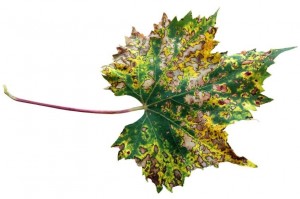If you are going to grow your own food, you will need to understand how to identify and treat popular plant diseases that you will run into. One that seems to pop up for me every few years is anthracnose.
Anthracnose is a common fungal disease that will cause a part of your vegetable plant to turn dark or sunken. It affects just about any type of vegetation in your home vegetable garden. If not handled quickly it can reduce your home vegetable garden to nearly nothing in just a few days.
IDENTIFY THE PROBLEM
To identify whether or not your plants have or are developing anthracnose, check for small, yellow or brown spots on the leaves, although they can appear on any part of the plant. You will want to look under branches, stems, leaves and so on.
As a side note, your chances are greater that your plants will contract anthracnose if you live on the east coast. The humid weather and fluctuating temperatures makes it perfect for anthracnose to spread.
ORGANIC FUNGICIDE OPTIONS
One of the best treatments for anthracnose is a copper fungicide. There are copper fungicides on the market that have been approved for organic purposes. You will have to locate what is available to you in your area as they are available at most garden centers.
However, if the anthracnose is too far along to the point that it has spread deep into the plant, the fungicide will do you no good. These types of sprays work well if you are able to detect anthracnose early enough. Early detection is the key.
DISCARDING DISEASED PLANTS
If you are past the point where fungicides will not help, you unfortunately must remove the infected plant. Because anthracnose is a fungal disease, it can spread fairly easily, and that means you want to remove the infected plant before it gets to the remainder of your garden.
You will also want to discard of the affected plant in to your regular trash. Do not add these to your compost pile. Anthracnose may over winter and all you will be doing is setting yourself up for disaster if you use that compost the following season.
CHOOSE WISELY
If you live in an area where you are susceptible to anthracnose, I would recommend choosing plant varieties that are resistant. If you like to grow your vegetable garden all from seed, like me, choose new seeds each season if your plants were infected and absolutely do not save any seeds from plants that had anthracnose.
SOIL CONDITIONS
Make sure you have healthy soil. Healthy soil is enriched with good quality organic matter such as compost and well aged manure. A healthy soil helps keep your plants healthy and that means they have the ability to fight off many diseases and pests.
WATER FROM BELOW
Water your plants with a soaker hose or drip irrigation. Wet leaves and a wet plant make for a perfect environment for any fungal disease to spread. By watering your plants at the ground level, the plant itself stays dry.
CROP ROTATION
Finally, rotate your plants every season. Never plant the same types of vegetables or members of the same family in the same spot in consecutive years. By moving your plants around from year to year, it makes it harder for diseases to get a stronghold in your garden.

